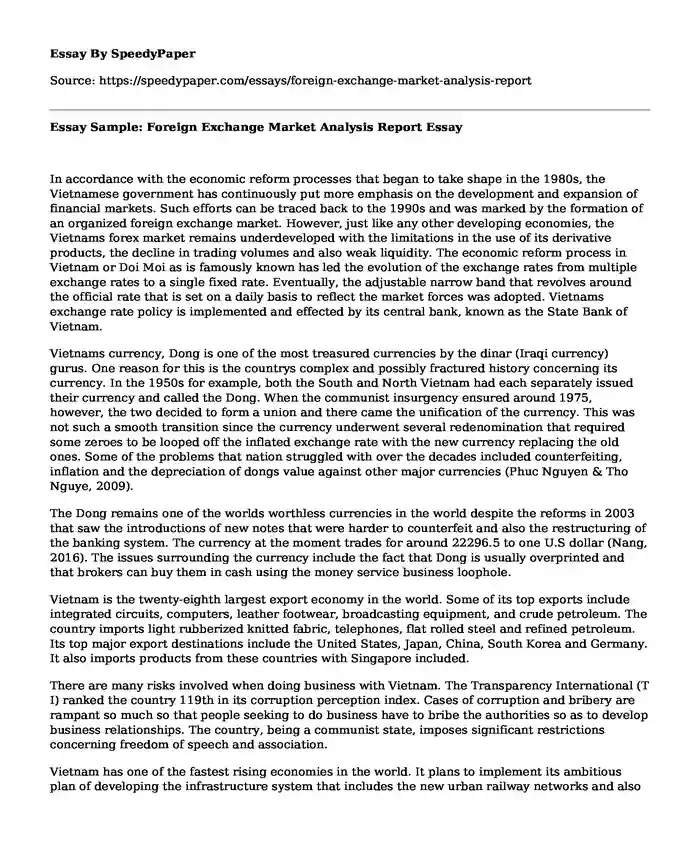In accordance with the economic reform processes that began to take shape in the 1980s, the Vietnamese government has continuously put more emphasis on the development and expansion of financial markets. Such efforts can be traced back to the 1990s and was marked by the formation of an organized foreign exchange market. However, just like any other developing economies, the Vietnams forex market remains underdeveloped with the limitations in the use of its derivative products, the decline in trading volumes and also weak liquidity. The economic reform process in Vietnam or Doi Moi as is famously known has led the evolution of the exchange rates from multiple exchange rates to a single fixed rate. Eventually, the adjustable narrow band that revolves around the official rate that is set on a daily basis to reflect the market forces was adopted. Vietnams exchange rate policy is implemented and effected by its central bank, known as the State Bank of Vietnam.
Vietnams currency, Dong is one of the most treasured currencies by the dinar (Iraqi currency) gurus. One reason for this is the countrys complex and possibly fractured history concerning its currency. In the 1950s for example, both the South and North Vietnam had each separately issued their currency and called the Dong. When the communist insurgency ensured around 1975, however, the two decided to form a union and there came the unification of the currency. This was not such a smooth transition since the currency underwent several redenomination that required some zeroes to be looped off the inflated exchange rate with the new currency replacing the old ones. Some of the problems that nation struggled with over the decades included counterfeiting, inflation and the depreciation of dongs value against other major currencies (Phuc Nguyen & Tho Nguye, 2009).
The Dong remains one of the worlds worthless currencies in the world despite the reforms in 2003 that saw the introductions of new notes that were harder to counterfeit and also the restructuring of the banking system. The currency at the moment trades for around 22296.5 to one U.S dollar (Nang, 2016). The issues surrounding the currency include the fact that Dong is usually overprinted and that brokers can buy them in cash using the money service business loophole.
Vietnam is the twenty-eighth largest export economy in the world. Some of its top exports include integrated circuits, computers, leather footwear, broadcasting equipment, and crude petroleum. The country imports light rubberized knitted fabric, telephones, flat rolled steel and refined petroleum. Its top major export destinations include the United States, Japan, China, South Korea and Germany. It also imports products from these countries with Singapore included.
There are many risks involved when doing business with Vietnam. The Transparency International (T I) ranked the country 119th in its corruption perception index. Cases of corruption and bribery are rampant so much so that people seeking to do business have to bribe the authorities so as to develop business relationships. The country, being a communist state, imposes significant restrictions concerning freedom of speech and association.
Vietnam has one of the fastest rising economies in the world. It plans to implement its ambitious plan of developing the infrastructure system that includes the new urban railway networks and also the expansion of regional and international airports in the next ten years. The constant devaluation of gong currency according to Nguyen (2015) served to benefit the exporters more. The move was also disadvantageous to the importers since it drives up the costs of imports leading to inflation in a country that has for a long time had to deal with an unstable economy.
References
Doing business in Vietnam: Vietnam trade and export guide - GOV.UK. (2016). Gov.uk. Retrieved 9 May 2016, from https://www.gov.uk/government/publications/exporting-to-vietnam/exporting-to-vietnam
Nang, D. (2016). Vietnam: Banks & Money - TripAdvisor. Tripadvisor.co.uk. Retrieved 9 May 2016, from https://www.tripadvisor.co.uk/Travel-g293921-s601/Vietnam:Banks.And.Money.html
Nguyen, T. (2015). Vietnam Devalues the Dong to Combat Impact of International Markets. Radio Free Asia. Retrieved 9 May 2016, from http://www.rfa.org/english/news/vietnam/currency-05082015144443.html
Phuc Nguyen, T. & Tho Nguye, D. (2009). VIETNAMS EXCHANGE RATE PO LICY AND IMPLICATIONS FOR ITS FOREIGN EXCH ANGE MARKET, 1986-2009 (p. 31). Nathan: Griffith Business School. Retrieved from https://www.ecu.edu.au/__data/assets/pdf_file/0020/200936/8.2-VN-FX-Market-Nguyen-2010-08-15.pdf
Vietnam Country Economy: Risk Analyses by EH Economic Research. (2016). Eulerhermes.com. Retrieved 9 May 2016, from http://www.eulerhermes.com/economic-research/country-reports/Pages/Vietnam.aspx
Cite this page
Essay Sample: Foreign Exchange Market Analysis Report. (2019, Sep 17). Retrieved from https://speedypaper.net/essays/foreign-exchange-market-analysis-report
Request Removal
If you are the original author of this essay and no longer wish to have it published on the SpeedyPaper website, please click below to request its removal:
- Essay Example on the Examining the Activities of the Green Party
- Free Essay Sample on School Shootings
- Essay Example: Curriculum Unit Plan
- Essay Sample: Burning, Resiliency, and Absorbency Tests on Various Fabrics
- What is the mission of your school?
- Essay Example on Pneumonia
- 2. Deteriorating quality 1. Transparency in pricing and invoicing
Popular categories





